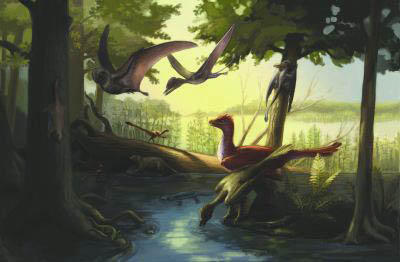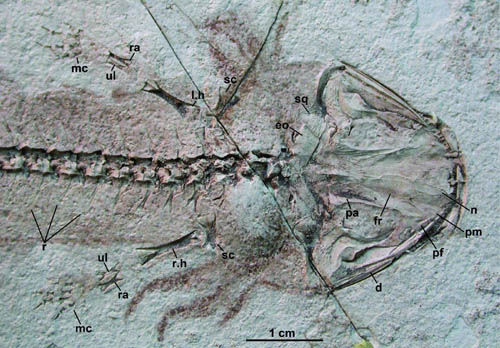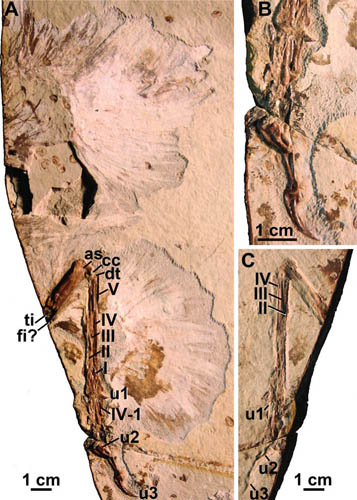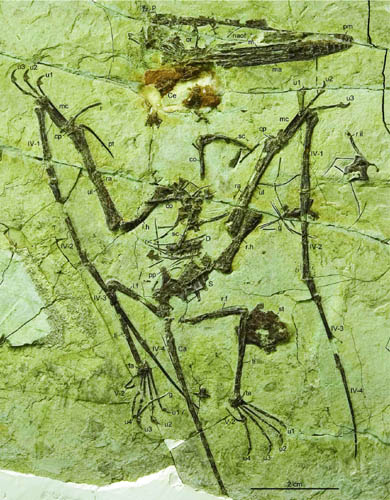| Location: Home > Research > Research Progress |
| The Incredible Daohugou Biota Reveals the Jurassic Life of Northeast Asia |
|
A new paper published in the Journal of Vertebrate Paleontology 34 (2) described 30 Jurassic creatures – five salamanders, one anuran, two lizards, 13 pterosaurs, five dinosaurs, and four mammals from the so-called Daohugou Biota, a fossil assemblage newly named after a village near one of the major localities in Inner Mongolia, China, helping better understand the Jurassic life of northeast Asia, about 160 million years ago. The Early Cretaceous Jehol Biota of northeastern China has become well known over the last two decades as a source of feathered avialan and non-avialan theropods, preserved alongside an array of other fossil vertebrates, invertebrates, and plants. Still more recently, a rich assemblage , the Daohugou Biota, has begun to emerge from Jurassic strata in the same region. Like their counterparts from the Jehol Biota, Daohugou Biota vertebrate specimens are typically preserved in fine-grained lacustrine beds and often retain feathers and other soft-tissue features. The presence of the salamander Chunerpeton tianyiensis, proposed in this new study as an index fossil for the Daohugou Biota, links the Daohugou locality to five other fossil-producing areas in the provinces of Hebei and Liaoning. The strata containing the Daohugou Biota are close to the Middle–Upper Jurassic boundary and belong at least partly to the regionally widespread Tiaojishan Formation. In general, the vertebrate fauna of the Daohugou Biota is strikingly different from that of the Jehol Biota, although paravian dinosaurs, anurognathid pterosaurs, and salamanders with cryptobranchid and hynobiid affinities occur in both. "The Daohugou Biota gives us a look at a rarely glimpsed side of the Middle to Late Jurassic – not a parade of galumphing giants, but an assemblage of quirky little creatures like feathered dinosaurs, pterosaurs with ‘advanced’ heads on ‘primitive’ bodies, and the Mesozoic equivalent of a flying squirrel,” said lead author Dr. Corwin Sullivan from the Institute of Vertebrate Paleontology and Paleoanthropology (IVPP) of the Chinese Academy of Sciences. Almost more impressive than the diversity of the biota is the preservation of many of the vertebrate specimens, including complete or nearly-complete skeletons associated with preserved soft tissues such as feathers, fur, skin or even, in some of the salamanders, external gills. "The Daohugou amphibians are crucially important in the study of the phylogeny and early radiation of modern amphibian groups,” said co-author Dr. WANG Yuan , a research professor of IVPP. Because the Daohugou Biota and the much better studied Jehol Biota are similar in preservational mode and geographic location, but separated by tens of millions of years, they give paleontologists an outstanding, even unique, opportunity to study changes in the fauna of this region over a significant span of geological time and an important period in vertebrate evolution. "The Cretaceous feathered dinosaurs of northeastern China have been astonishing paleontologists and the public for almost two decades now, and the Daohugou Biota preserves their Jurassic counterparts in the same region. As prequels go, it’s pretty exciting,” Dr. Sullivan said. Nevertheless, the Daohugou Biota and the Jehol Biota are two successive Lagerstätte assemblages that collectively offer a taphonomically consistent window into the Mesozoic life of northeast Asia over a significant span of geologic time. This work was supported financially by the Chinese Academy of Sciences, the National Natural Science Foundation of China, and the Ministry of Science and Technology of China.  Fig.1 Reconstruction of the Daohugou fauna featuring feathered dinosaurs, pterosaurs, early mammals and amphibians among others. (Image by Julia Molnar)  Fig.2 Forequarters of typically preserved specimen (IVPP V13343) of the salamander Chunerpeton tianyiensis, showing impressions of skeletal elements and external gills. (Image by IVPP)  Fig.3 Holotype of the derived maniraptoran dinosaur Pedopenna daohugouensis (IVPP V12721). A, main slab; B, detail of right pes on main slab; C, right distal hind limb as preserved on counterpart slab. (Image by IVPP)  Fig.4 Holotype of the pterosaur Darwinopterus linglongtaensis (IVPP V16049). (Image by IVPP)  Fig.5 Holotype of the scansoriopterygid dinosaur Epidexipteryx hui (IVPP V15471). A, counterpart slab photographed under visible light; B, main slab photographed under ultraviolet light. (Image by IVPP) |